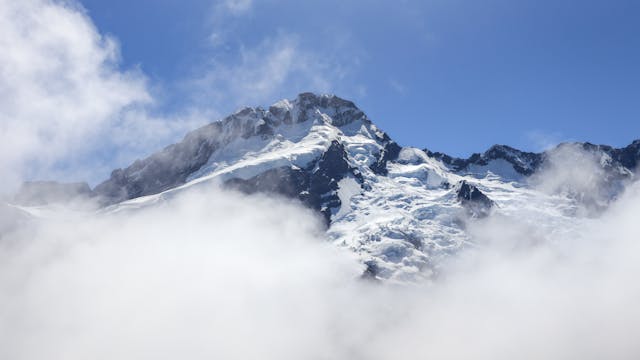
What causes an avalanche or landslide? The causes of avalanches and landslides do have some similarities, but landslides involve the movement of rock, earth, and debris, while avalanches involve snow and ice.
An avalanche starts when an unstable mass of snow and ice breaks loose and slides down the slope. The avalanche picks up speed and other matter as it travels. Very large avalanches can carry millions of tons of snow and travel at over 320 km an hour. There are a lot of avalanches a year, probably a million, and they range from small ones to large ones. The majority of them happen in places where there are no people, so we don’t hear about them. We only tend to hear about the ones that affect us. Avalanches kill roughly 150 people a year.
There are several causes of an avalanche. The steepness of the slope is a factor. Snow will have more trouble staying in place on a steeper slope than on a shallower one. The weather is a factor. Strong winds can push the snow. Human activity can dislodge the snow. But one of the main causes is the weight of the snow. Avalanches only happen if there is enough snow. More often than not, avalanches happen after a lot of snow has built up over the season. Newly fallen snow has a very fluffy crystal structure. It is light and full of air. As more snow falls, the lower layers of snow get crushed down, and the air is forced out. The snow also melts and refreezes as the temperatures fluctuate. This changes the shape of the snow particles from crystalline and fluffy to very granular, almost like sugar. This structure is not as strong.
There are many layers of snow that build up through the season, and each new layer sits on top of the one below it. They are connected horizontally, but not vertically. All of the layers need to be strong to keep the snow in place. If there is weakness in one layer, it can break off and all of the snow that it is supporting will slide down the hill. Once the snow has started moving, the slab will break up, and it will pick up more snow. Snow seems really fluffy, but if you are in one of these avalanches, the granules will settle with almost no air between them, somewhat like concrete. It is almost impossible to get yourself out of an avalanche once the snow has settled.
A landslide is similar to an avalanche because a large amount of matter comes sliding down a slope, but it is made up of rock, earth, and whatever else is on the slope. The cause is relatively similar. Both avalanches and landslides happen when the base layer becomes too loose to support all that is on top of it. With a landslide, that can have a few causes. One of the causes is the type of material the base layer is made up of. It could be a type of rock that is potentially weak or cracks easily. All rocks can break if given long enough, but some crack more easily. Weathering can also cause cracks to form. If water gets in the cracks and then it freezes and thaws as the temperature changes, it can break up the rock. Another reason might be that the vegetation on the slope has been removed. Plants and trees have long roots that hold the ground together. If the plants and trees are removed by people, or maybe by a fire, the ground will be a lot looser and more likely to slide. Another cause is rain. If there is a lot of rain or a lot of water running down the hill, it can make a lubricated layer underneath the base layer. If there is enough water to remove the friction holding the base layer in place, the whole layer can start to slide. A landslide can also be caused by an earthquake or a volcano. The 1980 eruption of Mt. St. Helens in Washington caused a landslide of 2.9 cubic kilometers that covered 62 square km after it finally came to a stop.
These are just a few of the causes of avalanches and landslides. Landslides don’t have to be on natural slopes. In 1966 in Wales, there was a landslide on the waste pile next to the coal mine. The landslide hit the town of Aberfan, just below it, and the moving coal waste killed 144 people, 116 of them children in a local school. There were many problems that led to the disaster, but it was affected by heavy rain that turned the waste into a sludge that didn’t have the friction to keep it in place. Just like an avalanche, when the coal waste sludge stopped moving, it solidified. And this is what I learned today.
Sources
https://www.cbsnews.com/news/what-causes-avalanches-how-to-survive
https://education.nationalgeographic.org/resource/avalanche
https://www.sfu.ca/~yla312/IAT%20235/P04_week%2013/what-causes-avalanche.html
https://education.nationalgeographic.org/resource/landslide
https://en.wikipedia.org/wiki/Aberfan_disaster
Photo by Marek Piwnicki: https://www.pexels.com/photo/above-the-clouds-16015219/
